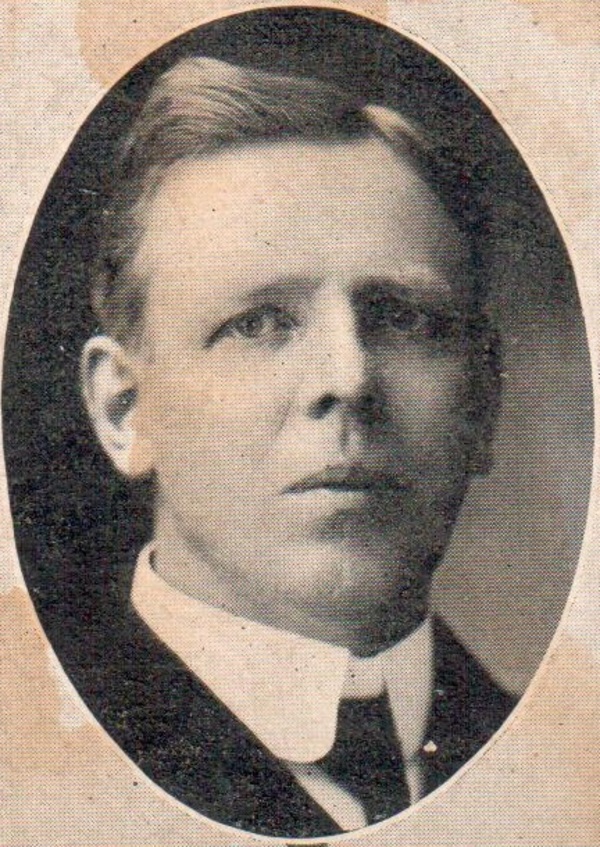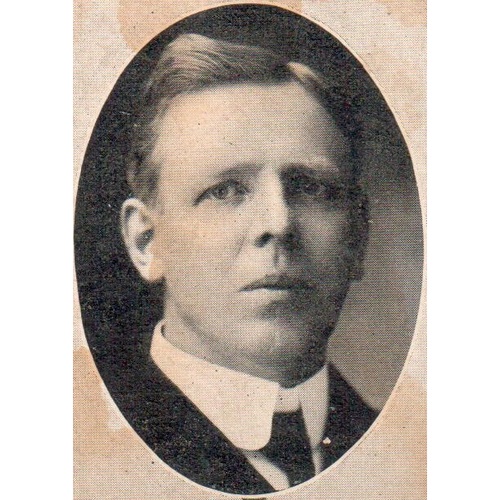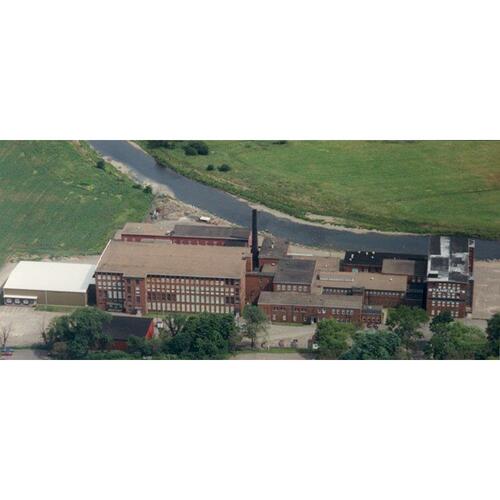
Source: Link
STANFIELD, JOHN, businessman, politician, and militia and army officer; b. 18 May 1868 in Charlottetown, eldest son of Charles Edward Stanfield and Lydia Dawson; m. 5 June 1902 Sarah (Sadie) Yorston in Truro, N.S, and they had two sons; d. there 22 Jan. 1934.
John Stanfield was born two years before his English-emigrant father moved his woollen mill from Tryon, P.E.I., to Truro. After receiving his education in local public schools, he was apprenticed at Pacific Mills in Lawrence, Mass., then one of the largest textile manufacturers in the world, with a view to his entering the family business. In 1896 John and his younger brother Frank purchased the firm from their father at his invitation, using money he supplied at interest. The brothers quickly reconstructed the enterprise, deciding to specialize in high-quality underwear that would, thanks to a process they themselves developed, be shrinkproof. Incorporated as the Truro Knitting Mills Company Limited in 1902, the business was reincorporated as Stanfield’s Limited early in 1906 with John as president and Frank as vice-president and managing director. John, who oversaw the manufacturing and technical side of the operations, remained president until 1924, when the company was again reorganized and he yielded the office to Frank. He then assumed the vice-presidency, a position he held until the end of his life.
John Stanfield was more politician than businessman – unlike his precocious brother, who was effectively both. The Stanfield dynasty in federal politics began with “Honest John,” who became president of the Colchester County Conservative Association in 1906. When a federal by-election was called in the riding in November 1907, Stanfield offered and, contrary to all expectations, took the seat for the Conservatives; he thus penetrated the “solid eighteen” Liberal phalanx that had been victorious in Nova Scotia in the general election three years earlier. He was also successful in 1908 and 1911. He was never an active debater, the Toronto Globe noting in its obituary that he was “not given to speech-making.” There was talk of a cabinet post for Stanfield when Robert Laird Borden took office as prime minister in October 1911 but Nova Scotia was left out of the administration, New Brunswick receiving two portfolios (both of which went to John Douglas Hazen). Stanfield had to settle for the role of chief government whip.
Stanfield’s ten years as an mp were ultimately ended by the conscription crisis and the electoral rearrangements consequent upon the formation of Borden’s Union government in October 1917. A safe seat was needed for Fleming Blanchard McCurdy*, who had had to make way in the riding of Shelburne and Queens for William Stevens Fielding*, a pro-conscription Liberal whom McCurdy had defeated in 1911. Stanfield was prevailed upon to stand down, and McCurdy ran unopposed in Colchester in the general election of December 1917. Circumstantial evidence suggests that the quid pro quo was the reversion to Stanfield of the first Senate vacancy for Nova Scotia. And, indeed, after the death of Senator William Dennis in July 1920, Stanfield was elevated to the upper house in February. The appointment was timely, given that the government of Prime Minister Arthur Meighen* was defeated in December 1921.
In England when World War I erupted in August 1914, Stanfield, who belonged to the active militia, had quickly returned to Canada and offered his services to the Department of Militia and Defence. In January 1916 the 193rd Infantry Battalion was authorized and Stanfield was named commanding officer with the rank of lieutenant-colonel. Popular with recruits, the so-called Blue Feather Battalion (“Stanfield’s Unshrinkables”) would never be operational outside Canada and England. Instead it would be broken up, providing drafts for front-line fighting units in France. In September 1916 Stanfield became temporary commandant of the Nova Scotia Highland Brigade, formed earlier that year with the 193rd as one of its components. His military career ended prematurely, however. After going overseas in October, already in poor health, he was declared by a medical board unfit for further service and invalided home; he was subsequently discharged and placed on the reserve list. Stanfield was one of several serving mps who both raised and commanded a unit in the Canadian Expeditionary Force.
Stanfield’s Senate career was uneventful. No sooner had the federal Conservatives been restored to power in Ottawa in July 1930 than the lieutenant governorship of Nova Scotia became available. Prime Minister Richard Bedford Bennett*’s understandable desire to rid himself of the discredited Unionist old guard – especially those who may not have supported him in the party-leadership campaign of 1927 – gave rise to rumours that Stanfield would be kicked upstairs; the senator was insulted and, when offered the position, he declined. Instead, the appointment went to his brother Frank, who viewed the office as an honour to the family. John may have resented the fact that he had not been seriously considered for cabinet rank in Bennett’s new government; the prime minister chose as Nova Scotia’s representative Premier Edgar Nelson Rhodes*, who then resigned his provincial office.
After Stanfield’s unexpected death from a stroke in January 1934, his Senate seat remained empty for 18 months. It was one of four Nova Scotia Senate vacancies filled in the dying days of the Bennett administration in July 1935. Historian John English has described John Stanfield as “a notorious political manipulator” and the characterization may well be apt. He was an activist who more or less gave up business for partisan affairs, at which he was undoubtedly successful. The political gene was prominent in the next generation of Stanfields: one of John’s nephews, Robert Lorne*, became premier of Nova Scotia and later leader of the opposition in Ottawa, and another, Frank Thomas, succeeded to his old federal seat. Stanfield’s place on the directorate of the Acadia Trust Company, the family’s investment arm, of which he had been president since his brother Frank’s appointment as lieutenant governor in late 1930, was taken by a third nephew, Charles Edward Stanfield II. Of his own sons, one became a civil engineer and the other had a career in advertising.
John Stanfield’s personal and political papers have apparently not survived; records of Stanfield’s Limited during his career are privately held. His wartime activities are well documented at LAC by his military personnel record in RG 150, Acc. 1992–93/166, box 9228-47 and by the records of the 193rd Infantry Battalion (see the section on infantry battalions in the guide “Sources relating to units of the Canadian Expeditionary Force,” Infantry Battalions, 193rd Battalion: www.bac-lac.gc.ca/eng/discover/military-heritage/first-world-war/Documents/infantry%20battalions.pdf (consulted 19 Feb. 2016)). Among the other useful primary sources are Colchester County Registry of Probate (Truro, N.S.), no.3883 and LAC, R14423-0-6 and R6113-0-X. The following newspapers are helpful: Acadian Recorder (Halifax), Citizen (Truro), Colchester Sun (Truro), Halifax Chronicle, Halifax Herald, and Truro Daily News.
Globe, 23 Jan. 1934. J. L. Colvin, “The sons of the man who made the business,” Maclean’s, 1 Sept. 1920: 32–34. John English, The decline of politics: the Conservatives and the party system, 1901–20 (Toronto and Buffalo, N.Y., 1977). A short history & photographic record of the Nova Scotia Highlanders, 193rd overseas battalion, C.E.F., Lt. Col. John Stanfield, commanding officer (n.p., 1916).
Cite This Article
Barry Cahill, “STANFIELD, JOHN,” in Dictionary of Canadian Biography, vol. 16, University of Toronto/Université Laval, 2003–, accessed December 31, 2025, https://www.biographi.ca/en/bio/stanfield_john_16E.html.
The citation above shows the format for footnotes and endnotes according to the Chicago manual of style (16th edition). Information to be used in other citation formats:
| Permalink: | https://www.biographi.ca/en/bio/stanfield_john_16E.html |
| Author of Article: | Barry Cahill |
| Title of Article: | STANFIELD, JOHN |
| Publication Name: | Dictionary of Canadian Biography, vol. 16 |
| Publisher: | University of Toronto/Université Laval |
| Year of publication: | 2018 |
| Year of revision: | 2018 |
| Access Date: | December 31, 2025 |





